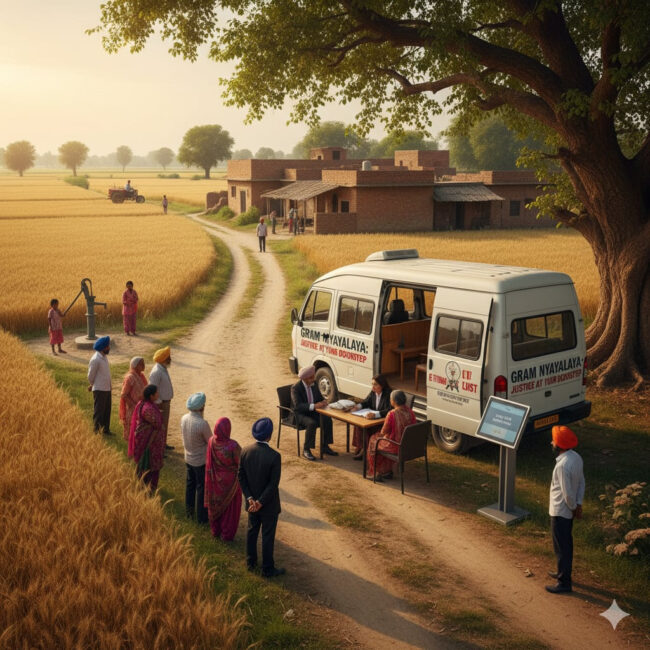 The opposition by several bar associations in Punjab to the rollout of Gram Nyayalayas confuses professional convenience with constitutional principle. When rural citizens must travel long distances, pay prohibitive fees, and forgo daily wages merely to secure a hearing, “access to justice” becomes a slogan rather than a guarantee. Properly implemented, village courts are an essential means of repairing that breach. They do not compete with regular courts; they supplement rather than supplant the justice system’s reach.
The opposition by several bar associations in Punjab to the rollout of Gram Nyayalayas confuses professional convenience with constitutional principle. When rural citizens must travel long distances, pay prohibitive fees, and forgo daily wages merely to secure a hearing, “access to justice” becomes a slogan rather than a guarantee. Properly implemented, village courts are an essential means of repairing that breach. They do not compete with regular courts; they supplement rather than supplant the justice system’s reach.
This resistance crystallised at a Joint Meeting of Presidents and office bearers of various Bar Associations of Punjab, held on 1 November 2025 at the Circuit House in Ludhiana. The gathering unanimously resolved to oppose the establishment of Gram Nyayalayas anywhere in the State and to register a united protest. As a consequence, a strict Pen-Down Strike (No Work Day) was called across Punjab for 3 and 4 November 2025, signalling a coordinated challenge by the legal fraternity to a reform that seeks precisely what the Constitution promises—justice that is fair, just, equitable, and accessible to all.
The Pendency Crisis in Punjab
As of January 2025, Punjab’s district courts were sitting on more than 8.45 lakh pending cases, with nearly two-thirds of them over a year old. Average disposal times stretch to over three years in civil cases and almost a year in even oridinary criminal matters. This is not a temporary bottleneck—it is systemic collapse. A farmer with a land dispute or a widow seeking maintenance cannot wait indefinitely. When justice takes years, it becomes indistinguishable from denial.
Gram Nyayalayas: A Proven Model
Against this grim reality, Gram Nyayalayas are not a theoretical reform but a demonstrated success. Nationwide, over 313 such courts have been operational, disposing of nearly three lakh cases in the last four years. Punjab’s own record is particularly instructive: Moga and Rupnagar districts have achieved case-clearance rates of over 96%, far exceeding the state average for subordinate courts. Their fee structure, capped at a nominal ₹100 regardless of the value of the dispute, makes justice economically accessible to rural populations.
Dispelling the Resource Myth
Bar associations claim Gram Nyayalayas would “divert scarce judicial resources.” This argument misunderstands their design and purpose. These courts actually reduce pressure on district courts by resolving smaller disputes at the village level. They require minimal infrastructure—often functioning as mobile courts in existing government spaces—and use newly appointed or specially designated magistrates, rather than pulling judges from district benches.
Moreover, the real drain on judicial resources lies in inaction. Each delayed case consumes administrative time, adjournment costs, and public frustration. A decentralized model ensures that time and manpower are used where they matter most—at the community level.
Accessibility and Affordability: The Rural Reality
The most compelling case for Gram Nyayalayas lies in what rural litigants face today. Distance, travel costs, repeated court appearances, and high legal fees make district courts effectively inaccessible for the poor. A day in court often means two days of lost wages and one week’s worth of expense.
By contrast, Gram Nyayalayas bring justice to the doorstep. They reduce travel, save costs, and resolve smaller disputes quickly, allowing citizens to pursue legal redress without economic ruin. The Supreme Court has also flagged the nation’s slow rollout of village courts as a serious access-to-justice lapse—an alarming shortfall in fulfilling the constitutional promise of equal justice for all.
No Conflict with the Punjab Panchayati Raj Act, 1994
There is no inherent conflict between the Gram Nyayalayas Act, 2008 and the Punjab Panchayati Raj Act, 1994. The 1994 Act vests certain limited judicial functions in Gram Panchayats through elected members; the 2008 central law creates formal village courts presided over by trained judicial officers. They are parallel, complementary tracks. The central statute explicitly provides that Gram Nyayalayas are “in addition to” other courts, which includes forums created under state laws. In constitutional terms, the central law should prevail wherever there is overlap or potential inconsistency. Equally, where the 2008 Act is silent or its operation has not yet been extended to a particular category of disputes, Punjab must operationalise the 1994 Act’s Gram Panchayat judicial powers to ensure there is no vacuum in rural justice. This is cooperative federalism in practice: use the central framework as the primary path, and deploy the state law to fill gaps so citizens never lose access because one tier is missing or delayed.
The Economic Argument Beneath the Opposition
While bar associations couch their objections in administrative terms, their true concern seems professional and economic. Village courts, by handling petty cases locally, reduce the flow of minor litigation to district courts. Yet this should be viewed as success, not loss. The Constitution guarantees justice, not guaranteed case volume for advocates.
In fact, Gram Nyayalayas open new professional avenues. Lawyers can represent clients before these forums, participate in legal aid panels, or act as mediators. Expanding justice infrastructure expands opportunity; it does not diminish it.
The iconic building of the Punjab Civil Secretariat, Chandigarh.
Procedural Simplicity, Not Confusion
Another misplaced objection is that Gram Nyayalayas will create procedural confusion. In reality, their jurisdiction is clearly defined by statute—specific pecuniary limits and categories of offences are explicitly listed. Appeals follow the established hierarchy through district and high courts. States that have operationalised these courts in parallel with district judiciary have demonstrated that co-existence, not confusion, is the natural outcome.
Aligning with ADR and Arbitration Reforms
The recent emphasis on mediation, the well-established Legal Services Authorities Act, 1987 (through the Lok Adalat system) and the ongoing overhaul of arbitration law underline a coherent judicial trend: encouraging dispute-resolution outside of overburdened formal courts. Gram Nyayalayas Act, 2008 (Gram Nyayalayas) are a natural complement to this movement. They can integrate pre-litigation mediation and Lok Adalat settlement, promote community-level conciliation, and serve as the next step when settlement efforts fail. Meanwhile the proposed amendments to the Arbitration and Conciliation Act, 1996—under the Draft Bill of 2024 and further reforms scheduled for 2025—seek to streamline arbitration processes, mandate institutional arbitration, limit court interference, and enforce tighter time-limits and digital hearings.
Punjab should, therefore, view Gram Nyayalayas as part of a continuum—Lok Adalats and mediation for voluntary resolution, Gram Nyayalayas for low-value and localised disputes, arbitration for commercial or contract disputes under the new regime, and district courts for complex litigation. Together, they form a multi-tier model of accessible, efficient justice.
From Resistance to Implementation
Punjab’s government must move beyond confrontation and towards structured rollout. A practical roadmap could include:
Targeted Implementation: Begin in districts with the highest pendency and poorest access. Combine fixed sittings at block headquarters with mobile sittings across panchayats.
Smart Staffing: Assign trained first-class magistrates with paralegal support and a small legal-aid cell.
Digital Access: Introduce e-filing kiosks at panchayat offices, WhatsApp notifications for hearings, and public dashboards displaying cause lists and disposal rates.
Professional Partnership: Include bar associations in planning, create rosters of panel lawyers, and offer continuing legal education credits for those practising before Gram Nyayalayas.
Monitoring and Accountability: Establish quarterly audits under the High Court to review case management, adherence to due process, and user satisfaction.
Such a plan transforms opposition into collaboration, ensuring the system strengthens rather than fragments.

Upholding a Constitutional Mandate
The Gram Nyayalayas Act, 2008 is not optional policy—it is a statutory obligation that advances the constitutional right to equal access to justice. Non-implementation perpetuates inequality before the law. Punjab, with its deep democratic traditions and strong community ethos, should lead rather than lag.
Summing Up: Justice Must Travel to the People
Gram Nyayalayas are designed to supplement, not supplant the regular courts. They extend the reach of justice to where it is most needed—rural communities that have long remained on the periphery of the legal system.
Punjab cannot hope to clear its massive backlog by overloading the same congested system. The answer lies in multiplying access points, not restricting them. Gram Nyayalayas, combined with the expanding mediation framework, the Lok Adalat system, and the forthcoming reforms under the new Arbitration Act, create precisely the diversified justice architecture that the Constitution envisioned—one that is inclusive, efficient, and citizen-centred.
The bar associations’ stance—that justice is already “sufficient and accessible”—is contradicted by both data and lived experience. For millions in rural Punjab, the real obstacle is not ignorance of rights but the distance to a courtroom. Gram Nyayalayas, by functioning closer to where people live, will not only make justice fair, just, and expeditious, but will also open new avenues for young and energetic lawyers who have recently enrolled and are struggling to establish significant practice or clientele in district and sub-divisional headquarters. These village-level courts will give them opportunities to serve, learn, and grow while strengthening the justice system’s grassroots foundation.
The way forward is clear: embrace Gram Nyayalayas as the first and closest door to justice, let the central law lead, and allow the state law to fill any gaps—so that the promise of equal, fair, and accessible justice finally reaches the village square. In doing so, “Power to the People” will cease to be a rhetorical slogan and become a living reality—complemented by justice for the people, delivered at their very doorstep.